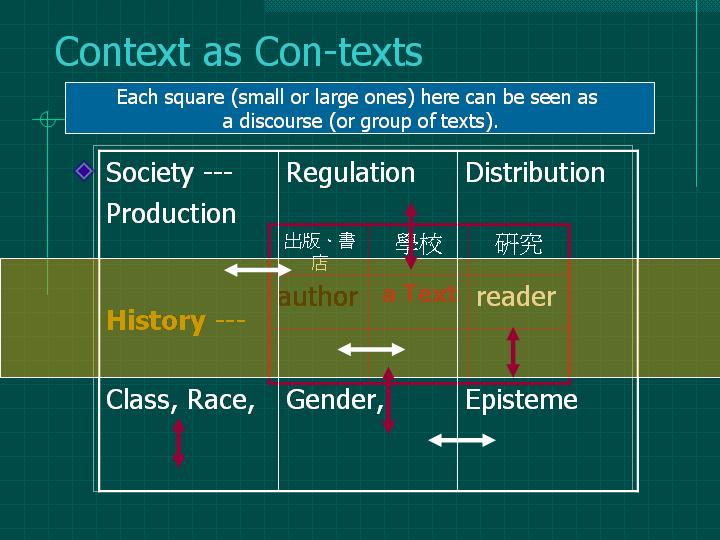![]()
Part II: Essay Questions (Choose 2 50%)
I. History, New Historicism,
Postcolonialism and Identity
![]()
|
1. Historical Methods: choose two of the following texts and compare and contrast the historical methods they use to present, refer to or conceal (as textual unsaid) a historical event (or some historical events) and the messages/ideologies they convey thereby. (For your reference, the various historical methods we've discussed are: the process of selection, synthesis and representation; with representation, you can choose to consider emplotment, embodiment [with dramatization or in characters, etc.], the use/exposure of narrative frames and perspective [e.g. multiple, partial or totalizing], and the establishment of credibility. Also, there is a difference in history shown as a 'time travel' and history as 'costume drama.') (Possible texts: "Rip Van Winkle,"Forrest Gump, Obasan, The Stunt Man, In Country, Hiroshima mon amour, "The Garden of the Forking Paths"). 2. Can the Subaltern speak? How do we translate/represent cultural, historical or class differences? Choose one of the following three pairs, analyze and compare how they present the colonial/racial Other and whether (and to what degree) are the latter allowed to speak. (1) Bhudda Bless Amerca and The Piano, (2) "The Man Who Would be King" and "The Adventure of Charles Augustus Milverton," (3) Forrest Gump and "My Man Bovanne" |
II.
Postmodernism,
Globalization and Trauma
![]()
|
1. Depthlessness vs. Aesthetic Self-Reflexivity in Media Representation: In this postmodern society of overall commodification, disorganized capitalism and telecommunication, signs are produced, exchanged and consumed at an ever-accelerating speed. These "economies of signs" can make cultural texts meaningless patische or self-reflexive parody, make readers shocked or blase (indifferent) consumers or conscious bricoleurs(developing their styles with the bits and pieces they collect). Also, they can make (media and Internet) communication frequent, intimate, or obscene, turning even a historical trauma into a spectacle for consumption. Please elaborate on these possiblities--remember to include both the positive and negative aspects--and give at least two examples of your own choice to illustrate your points. (If you don't have any examples at hand, you can use the sequence of Àsªº¶Ç¤H 1, 2, 3, Andy Warhol's works, Cindy Sherman's works and/or Forrest Gump as examples.) 2. Postmodern Simulation
and Nostalgia Film: 3. Identity and Hybridity: Hybridity is a term very rich with diverse meanings. It can be a consequence of colonial mimicry, immigration, as well as postmodern global interchanges of signs and commodities. Use your own examples to discuss people of hybrid identities. Do the hybrid signs and cultures they take on allow identity constructions? In other words, is hybridity empowering, disrupting or disintegrating our sense of identities? 4. Stories of Trauma: Two interrelated issues of trauma that we have discussed are: its belatedness and representation (as "acting out" or "workting through"). How do the the texts we have read deal with them (or one of them)? Choose two. (Possible texts: Atonement, Hiroshima mon amour, "Summer Flower," "Human Ashes," "Recollection," and "The Honey Pie") |
II.
Literary
Criticism and Cognitive Mapping
![]()
|
1. Critical Toolbox vs. Multiple Perspectives: Except for New Criticism, the many theoretical schools we are engaged in, and definitely the topics of globalization and trauma, do not really give us methodologies; rather they provide us different framework to place a literary text in, or different perspectives (or lenses) from which we can examine a text. How do different theoretical terms/concepts--such as: intentional fellacy, organic unity, discourse, ideology, structure of feeling, hegemony--we learned this semester imply different approaches? Choose a text we have discussed in class and use the terms mentioned above to examine it from two different perspectives. (If you can't think of any examples, consider using "Leda and the Swan" or Shakespeare's sonnet 29.) 2. Why is "context" an important thing to consider in analyzing a text? What does it mean for New Historicists to see context as "con-text" and for Foucault to see author not as the creator of a group of texts, but as a label on them? Please also compare the following two charts in their different ways of placing a text, and then use one text (of your own choice) to discuss its relations with its context(s). (Please note that 'context' can also be that of the readers.)
|
||||||||||||||||||||
¡@

